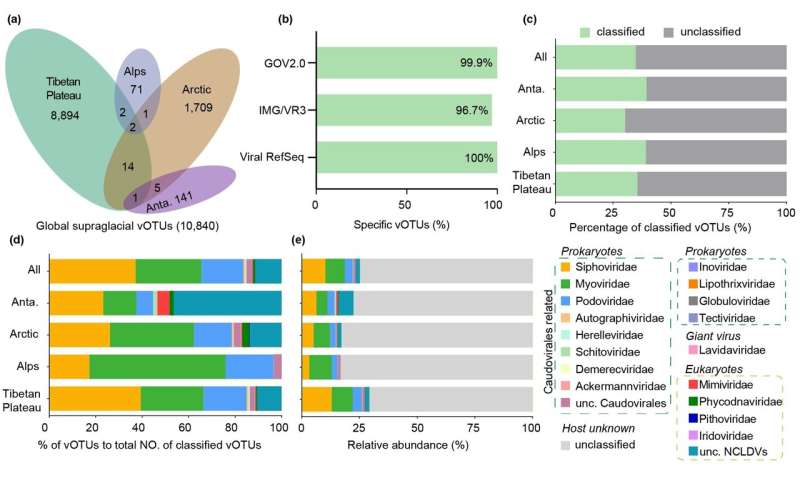This article has been reviewed according to Science X's editorial process and policies. Editors have highlighted the following attributes while ensuring the content's credibility:
fact-checked
trusted source
proofread
Scientists chart diversity, function and activity of global supraglacial DNA viruses

Supraglacial environments mainly consist of four main types of habitats for microbes and viruses, including snow, ice, meltwater and cryoconites (the granular sediment on glacier surfaces). A new paper published in Science Bulletin reveals that there were more than 10,000 viral species in global supraglacial environments. This is a 15-fold expansion of DNA viral genomic inventory ever known.
These viruses mainly belong to bacteriophages, viruses infecting bacteria. The researchers also found the viral communities showed a clear regional and habitat distribution pattern, with polar glacier samples separated from mountain glaciers of the Tibetan Plateau and cryoconites samples separated from snow and ice.
In addition, this work revealed a vigorous viral–host interaction in supraglacial environments. The team found that supraglacial viruses could be linked to ~83% of obtained prokaryotic phyla/classes and possessed the genetic potential to promote metabolism and increase cold adaptation, cell mobility, and phenolic carbon use of hosts in hostile environmental conditions using diverse auxiliary metabolic genes.
The on-site measurements carried out by Yongqin Liu and colleagues showed that the virus production rate could reach 2×108 VLPs g−1 h−1, which is similar to global ocean and freshwater lakes.
Finally, a thorough analysis of viral genomic content revealed that supraglacial DNA viruses as shuttles for antibiotic resistance genes (ARGs) and virulence factors (VFs). The researchers detected 122 (1.1% of total viral species) and 924 unique viral species (8.6% of total viral species) carrying 31 unique ARG types and 1,405 VFs coding genes. Hence, supraglacial DNA viruses might serve as mobile genetic elements for ARGs and VFs in glacier ecosystems.
In conclusion, this study provides a systematic view of the diversity and function of mountain and polar supraglacial DNA viruses. It emphasized the importance of viruses in supraglacial biogeochemical cycling and their potential impacts on downstream ecosystem sustainability. This study expands our knowledge of the diversity, function, and adaptability of supraglacial viruses, and provides a basis for future research on the world's glaciers.
More information: Yongqin Liu et al, Diversity and function of mountain and polar supraglacial DNA viruses, Science Bulletin (2023). DOI: 10.1016/j.scib.2023.09.007
Provided by Science China Press





















